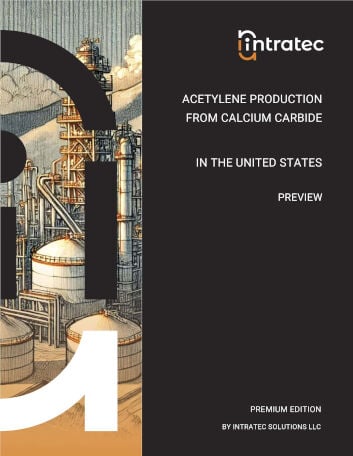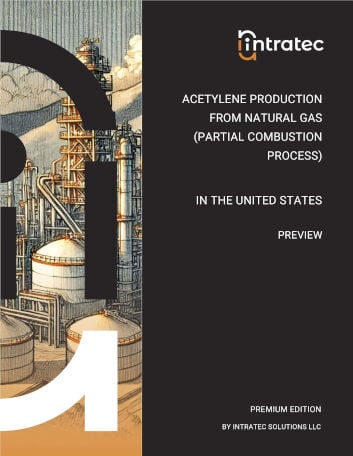Commodity Production Costs Report
Butanediol Production from Acetylene
Butanediol Plant Capital & Operating Cost Analysis | United States | Q3 2025
This report presents the economics of 1,4-Butanediol (BDO) production from acetylene and formaldehyde. The process examined is a typical acetylene-based Reppe process. Acetylene and an aqueous solution of formaldehyde (37 wt%) react to produce 1,4-butynediol. The butynediol is then hydrogenated to produce BDO.
The report provides a comprehensive study of Butanediol production and related Butanediol production cost, covering three key aspects: a complete description of the Butanediol production process examined; an in-depth analysis of the related Butanediol plant capital cost (Capex); and an evaluation of the respective Butanediol plant operating costs (Opex).
The Butanediol production process description includes a block flow diagram (BFD), an overview of the industrial site installations, detailing both the process unit and the necessary infrastructure, process consumption figures and comprehensive process flow diagrams (PFD). The Butanediol plant capital cost analysis breaks down the Capex by plant cost (i.e., ISBL, OSBL and Contingency); owner's cost; working capital; and costs incurred during industrial plant commissioning and start-up. The Butanediol plant operating costs analysis covers operating expenses, including variable costs like raw materials and utilities, and fixed costs such as maintenance, labor, and depreciation.

The process under analysis comprises three major sections: (1) Addition; (2) Hydrogenation; and (3) Purification.
Addition. Formaldehyde, pressurized acetylene, and caustic soda are fed to the Addition Reactor, along with catalyst and product streams recovered downstream, yielding a butynediol solution. The reactor effluent passes through a catalyst recovery area and then routed to a butynediol column to remove impurities. The bottom stream, containing butynediol, is sent to the hydrogenation section.
Hydrogenation. The butynediol solution is then fed to a fixed bed reactor, along with a pressurized hydrogen stream, where the main hydrogenation takes place, generating Butanediol. This reactor operates in hydrogen cycle gas mode. The unconverted butynediol is hydrogenated in another fixed-bed reactor, operating at slightly higher temperatures and without recirculating hydrogen. The reactor effluent is separated in a liquid stream, which is sent to a distillation train downstream, and a gas stream, comprising predominantly hydrogen, which is partly recycled, and partly disposed as off-gas.
Purification. In the first column of the distillation train, low boilers compounds are removed as overheads and discharged as waste. The bottom stream is directed to a drying column to remove water from the top and Butanediol as a bottom stream. The bottom is sent to a heavy ends removal, from where the top stream is sent to Butanediol purification, which generates a side stream of purified Butanediol that is sent to storage.
Report in PDF Format
Download & Explore Anytime
Access in Various Devices
Print & Read Comfortably
Share With Co-workers
Up-to-date Report
Professional report based on Q3 2025 economic data, ensuring timely evaluations.
Multiple Use Cases
Ideal for investment screening, feasibility studies, cost estimates, and research planning.
Proven Methodology
Developed using a consistent methodology honed over a decade, ensuring reliable cost analyses.
Report Editions
Content Highlights
Plant Capital Cost Summary
Summary outlining the capital cost required for building the Butanediol production plant examined.
Plant Capital Cost Details
Detailing of fixed capital (ISBL, OSBL & Owner’s Cost), working capital and additional capital requirements.
Plant Cost Breakdowns
Breakdown of Butanediol process unit (ISBL) costs and infrastructure (OSBL) costs; plant cost breakdown per discipline.
Operating Costs Summary
Summary presenting the operating variable costs and the total operating cost of the Butanediol production plant studied.
Operating Cost Details
Detailing of utilities costs, operating fixed costs and depreciation.
Plant Capacity Assessment
Comparative analysis of capital investment and operating costs for different Butanediol plant capacities.
Production Process Information
Block Flow Diagram, descriptions of process unit (ISBL) and site infrastructure (OSBL).
Process Consumptions
Raw materials and utilities consumption figures, by-products credits, labor requirements
Process Diagrams
Process flow diagrams (PFD), equipment list and industrial site configuration
Other Butanediol Production Cost Reports

Bio-Butanediol from Glucose (Succinic Acid as Intermediate)
This report examines the costs related to Butanediol production from glucose syrup. Initially, glucose is fermented to produce succinic acid, which is then hydrogenated to produce butanediol. The economic analysis is based on a plant constructed in the United States.
Details: 50 kta United States-based plant | Q3 2025 | 107 pages | Issue B | From $1,199 USD

Butanediol Production from Succinic Acid
This feasibility study examines 1,4-Butanediol (BDO) production from succinic acid in the United States using a hydrogenation process similar to the one proposed by BioAmber.
Details: 60 kta United States-based plant | Q3 2025 | 107 pages | Issue C | From $799 USD

Butanediol Production from Maleic Anhydride
This report presents an economic analysis of 1,4-Butanediol (BDO) production from maleic anhydride in the United States using a process similar to the one proposed by JM Davy. Initially, maleic anhydride is reacted with methanol to produce dimethyl maleate (DMM). The DMM is then hydrogenated to BDO.
Details: 75 kta United States-based plant | Q3 2025 | 107 pages | Issue E | From $799 USD
Bundle & Save
Purchase multiple Butanediol Production Cost reports and enjoy tiered discounts
up to 30% off!
Could Not Find the Report You Need?
Obtain a Bespoke Report
Get a report targeting the process in which you are interested
See Offer Details
Understand Bespoke Reports and how you can easily order them
Check Editions & Pricing
Complete a brief form and see a quotation for your Bespoke Report
Other Related Production Cost Reports

Hydrogen Production from Natural Gas (Partial Oxidation Process)
This study provides a techno-economic study of Hydrogen production from natural gas in the United States. In this analysis, natural gas is submitted to a thermal partial oxidation process, producing syngas, which is passed through a shift converter to enrich the Hydrogen output.
Details: 25 MM Nm3/y United States-based plant | Q3 2025 | 107 pages | Issue C | From $799 USD

Formaldehyde from Methanol (Silver Catalyst and Full Conversion)
This report presents a techno-economic study of Formalin (37wt% aqueous solution of Formaldehyde) production from methanol in the United States. The oxidation-dehydrogenation uses a silver-catalyzed reaction at conditions that prioritize full methanol conversion. In this case, methanol recovery is unnecessary.
Details: 60 kta United States-based plant | Q3 2025 | 107 pages | Issue B | From $799 USD

Acetylene Production from Calcium Carbide
This study presents the economics of Acetylene production from calcium carbide in the United States via wet process. In the process, calcium carbide reacts with water to form Acetylene. Hydrated lime is generated as by-product.
Details: 200 kta United States-based plant | Q3 2025 | 107 pages | Issue D | From $799 USD

Hydrogen Production from Natural Gas (Steam Reforming)
This report provides an economic analysis of Hydrogen production from natural gas in the United States using a steam reforming process. Initially, methane present in natural gas is cracked with steam generating syngas. Then, the carbon monoxide from syngas is reacted with steam, producing carbon dioxide and additional hydrogen.
Details: 1000 MM Nm3/y United States-based plant | Q3 2025 | 107 pages | Issue A | From $799 USD

Acetylene Production from Natural Gas (Partial Combustion Process)
This report presents the economics of Acetylene production from natural gas using a partial combustion process similar to that developed by BASF. In this process, methane from natural gas is cracked in high temperatures to acetylene and hydrogen. The economic analysis developed is based on a plant constructed in the United States.
Details: 50 kta United States-based plant | Q3 2025 | 107 pages | Issue A | From $799 USD

Formaldehyde from Methanol (Silver Catalyst and Methanol Recycle)
This report presents a techno-economic study of Formalin (37wt% aqueous solution of Formaldehyde) production from methanol in the United States by oxidation-dehydrogenation using a silver-catalyzed reaction at conditions that prioritize selectivity over conversion. In this case, unconverted methanol is recycled.
Details: 60 kta United States-based plant | Q3 2025 | 107 pages | Issue A | From $799 USD

Sodium Hydroxide Production from Sodium Chloride (Membrane Process)
This report presents the economics of Sodium Hydroxide production from sodium chloride in the United States, via a typical membrane process. In this process, sodium chloride is decomposed electrolytically, producing sodium hydroxide. Chlorine and hydrogen are generated as by-products in the process.
Details: 550 kta United States-based plant | Q3 2025 | 107 pages | Issue A | From $799 USD
+800 Reports Developed, Targeting +250 Commodities
Vast Report Library
858 independent and up-to-date reports examining embryonic and established production processes.
Free Sample Reports
Quickly understand the structure and depth of content of our professional reports.

